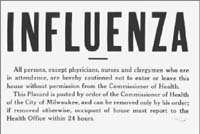
Page 2 of 6
The 1918 Spanish Flu lacks a place in the collective
memory of Wisconsin because of preoccupation with World War I. There was
a food conservation program along with other programs to aid the war effort.
Approximately 586,292 Wisconsin men registered, 122,215 served, and 3,932
servicemen died in the war. Our attention understandably was overseas,
with the loved ones.
On October 5th, 1918, The Daily Northwestern opined, "Influenza has
appeared here. City will fight to control it." On that day, local
physicians reported ten cases to the Oshkosh Police Department. Dr. Arthur
H. Broche, the City Health Commissioner, urged doctors to isolate patients
and report all cases. That evening, the last public dance was held at
Eweco Park, south of the city.
Two days passed. On October 7th, The Daily Northwestern
reported that two men had succumbed to the Spanish Flu. According to the
death records at the Winnebago County Courthouse, the first person to
die and bring la grippe into Oshkosh was John Daniel Jones, Jr. He was
the oldest of nine children and the son of John Daniel Sr. and Katherine
Perry, immigrants from Wales. John Jr. lived in Oshkosh until shortly
after his 18th birthday when he left home, looking for work in Kentucky.
Later, he moved to Belvidere, Illinois, to work as a machinist and core
maker for different federal government projects.
After working in Belvidere for five months, John registered for the army
and returned home to Oshkosh to take a military physical. Before leaving
for Oshkosh, John became sick but continued on to Oshkosh. He was admitted
into Mercy Hospital on October 4th and was pronounced dead on October
6th. On October 8th Dr. Broche filled out the death record, which listed
influenza and double lobar pneumonia as the contributors to death. He
was buried in Riverside Cemetery on October 9th.
 |
This same day another newspaper headline stated, "Views of doctors on how to handle grip don't agree. All say situation is serious. Some urge prompt closing and quarantines." By then 103 cases had been reported. Each time a case was reported, an influenza placard was placed on the door of the residence. No one was allowed to enter except nurses, doctors, or clergymen. The placard read: "Warning! Influenza here. This card must not be removed without authority. Milk dealers must not deliver milk in bottles." By October 10th, Neenah reported its first influenza cases. That same day, cases in Oshkosh climbed to 163 and a shortage of flowers for funerals was reported. Weeden Drug Company began advertising "Spanish Flu medicines and cures." The Oshkosh Savings and Trust Company ran several ad campaigns for wills. |
